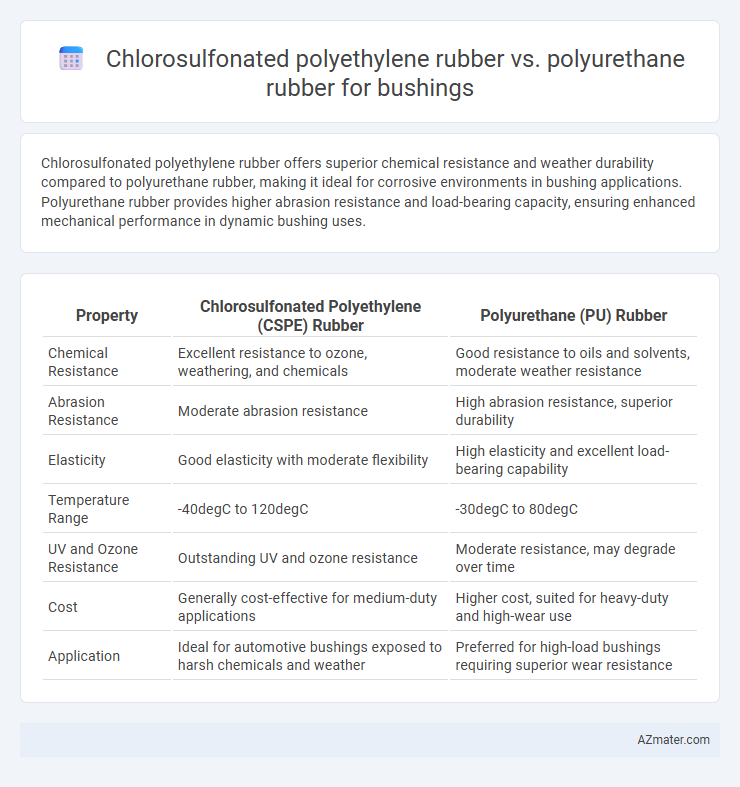Chlorosulfonated polyethylene rubber offers superior chemical resistance and weather durability compared to polyurethane rubber, making it ideal for corrosive environments in bushing applications. Polyurethane rubber provides higher abrasion resistance and load-bearing capacity, ensuring enhanced mechanical performance in dynamic bushing uses.
Table of Comparison
| Property | Chlorosulfonated Polyethylene (CSPE) Rubber | Polyurethane (PU) Rubber |
|---|---|---|
| Chemical Resistance | Excellent resistance to ozone, weathering, and chemicals | Good resistance to oils and solvents, moderate weather resistance |
| Abrasion Resistance | Moderate abrasion resistance | High abrasion resistance, superior durability |
| Elasticity | Good elasticity with moderate flexibility | High elasticity and excellent load-bearing capability |
| Temperature Range | -40degC to 120degC | -30degC to 80degC |
| UV and Ozone Resistance | Outstanding UV and ozone resistance | Moderate resistance, may degrade over time |
| Cost | Generally cost-effective for medium-duty applications | Higher cost, suited for heavy-duty and high-wear use |
| Application | Ideal for automotive bushings exposed to harsh chemicals and weather | Preferred for high-load bushings requiring superior wear resistance |
Introduction to Bushing Materials
Chlorosulfonated polyethylene (CSM) rubber offers excellent chemical resistance, ozone stability, and weather durability, making it suitable for bushings exposed to harsh environmental conditions. Polyurethane rubber provides superior abrasion resistance, high load-bearing capacity, and enhanced elasticity, ideal for bushings requiring durability under mechanical stress. Selection between CSM and polyurethane bushings depends on the application's specific demands for chemical exposure, mechanical wear, and environmental conditions.
Overview of Chlorosulfonated Polyethylene (CSM) Rubber
Chlorosulfonated polyethylene (CSM) rubber is known for its excellent resistance to chemicals, weathering, and ozone, making it highly suitable for demanding automotive bushing applications. Its strong chlorosulfonyl groups provide superior durability against oils, fuels, and solvents compared to polyurethane rubber, which offers better abrasion resistance but lower chemical stability. CSM's unique polymer structure enhances flexibility and aging resistance, positioning it as a preferred choice for bushings exposed to harsh environmental and operational conditions.
Overview of Polyurethane (PU) Rubber
Polyurethane (PU) rubber offers superior abrasion resistance, high tensile strength, and excellent elasticity, making it ideal for heavy-duty bushing applications where durability is critical. Unlike chlorosulfonated polyethylene (CSM) rubber, PU exhibits enhanced resistance to oils, solvents, and mechanical stress, extending bushing lifespan in automotive and industrial environments. PU's customizable hardness and resilience provide optimal vibration dampening and load-bearing capacity, outperforming traditional CSM rubber in demanding operational conditions.
Mechanical Properties Comparison
Chlorosulfonated polyethylene (CSM) rubber exhibits excellent resistance to chemicals, ozone, and weathering, making it highly durable for bushing applications subject to harsh environments. Polyurethane rubber offers superior tensile strength, abrasion resistance, and load-bearing capacity, providing enhanced mechanical performance under dynamic and high-stress conditions. Comparing mechanical properties, polyurethane rubber typically demonstrates higher tear resistance and elasticity, while CSM rubber excels in flexibility and long-term environmental stability.
Chemical Resistance: CSM vs PU Rubber
Chlorosulfonated polyethylene (CSM) rubber exhibits superior chemical resistance compared to polyurethane (PU) rubber, particularly against oils, acids, alkalis, and solvents, making it ideal for harsh industrial environments. PU rubber, while providing excellent abrasion and tear resistance, tends to degrade more rapidly when exposed to harsh chemicals such as hydrocarbons and strong oxidizers. For bushing applications requiring prolonged exposure to aggressive chemicals, CSM rubber offers enhanced durability and longevity over PU rubber.
Durability and Longevity in Bushing Applications
Chlorosulfonated polyethylene (CSPE) rubber exhibits exceptional resistance to weathering, ozone, and chemical exposure, making it highly durable for bushing applications subjected to harsh environmental conditions. Polyurethane rubber offers superior abrasion resistance and tensile strength, which extends the longevity of bushings under heavy mechanical stress and dynamic loading. Choosing between CSPE and polyurethane depends on the specific operational demands; CSPE is preferable for chemical and UV exposure, while polyurethane excels in wear resistance and mechanical durability.
Performance Under Extreme Temperatures
Chlorosulfonated polyethylene (CSM) rubber maintains exceptional flexibility and chemical resistance at temperatures ranging from -40degC to 150degC, making it ideal for bushings exposed to extreme thermal conditions. Polyurethane rubber offers superior mechanical strength and abrasion resistance but typically performs best within a narrower temperature range of -30degC to 80degC, which may limit its effectiveness in extreme cold or hot environments. For bushings requiring durability under severe temperature fluctuations, CSM rubber provides enhanced thermal stability and resilience compared to polyurethane variants.
Cost Effectiveness and Availability
Chlorosulfonated polyethylene (CSPE) rubber offers superior chemical resistance and weatherability compared to polyurethane, often resulting in increased material longevity and reduced replacement frequency, which enhances cost effectiveness for bushing applications. Polyurethane rubber, widely available and known for its excellent abrasion resistance and load-bearing capacity, typically incurs lower upfront costs and benefits from extensive manufacturing networks ensuring consistent supply. Choosing between CSPE and polyurethane hinges on balancing long-term durability against initial material costs and regional availability for optimized bushing performance.
Application Suitability for Different Industries
Chlorosulfonated polyethylene (CSM) rubber offers excellent chemical resistance, weathering durability, and ozone resistance, making it highly suitable for automotive and industrial bushings exposed to harsh environmental conditions. Polyurethane rubber provides superior abrasion resistance, load-bearing capacity, and elasticity, ideal for heavy machinery and construction equipment requiring enhanced wear performance and shock absorption. Both materials are chosen based on specific industry demands: CSM excels in outdoor, chemical-intensive applications, while polyurethane is preferred in high-impact, load-heavy environments.
Conclusion: Choosing the Right Rubber for Bushings
Chlorosulfonated polyethylene (CSM) rubber offers superior chemical resistance and excellent weatherability, making it ideal for bushings exposed to harsh environments and UV radiation. Polyurethane rubber provides exceptional abrasion resistance and higher load-bearing capacity, suited for applications requiring durability under mechanical stress. Selecting the right rubber depends on balancing environmental exposure and mechanical demands, with CSM favored for chemical and weather resilience, while polyurethane excels in wear resistance and strength.

Infographic: Chlorosulfonated polyethylene rubber vs Polyurethane rubber for Bushing
 azmater.com
azmater.com